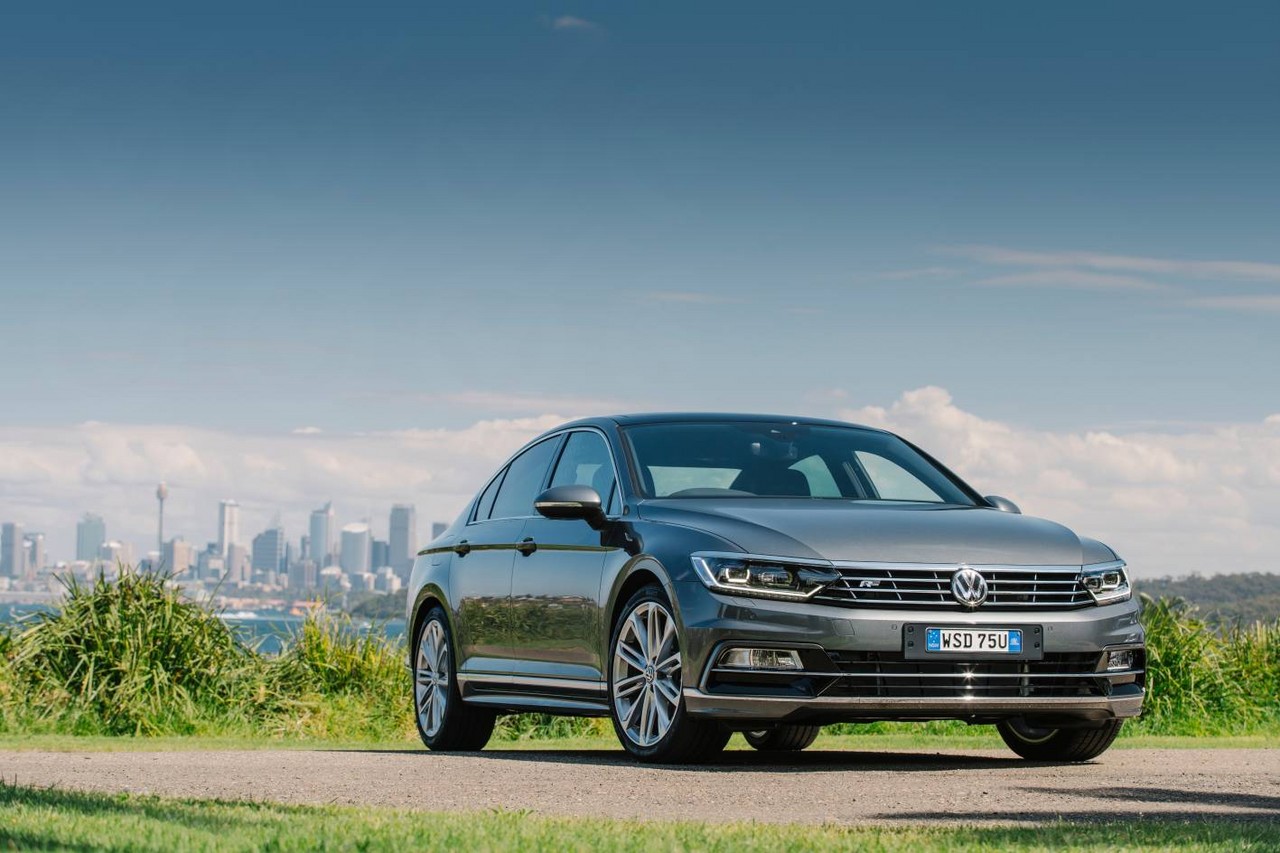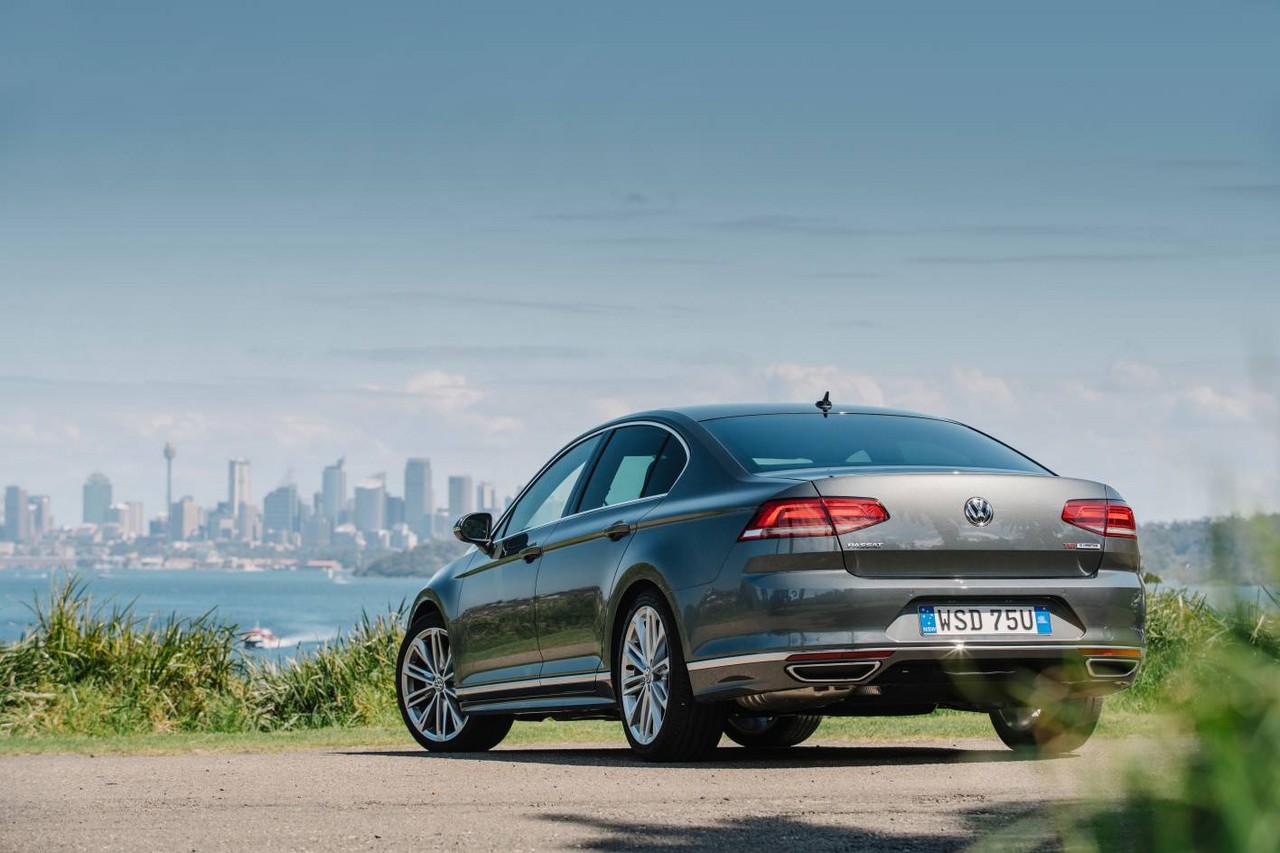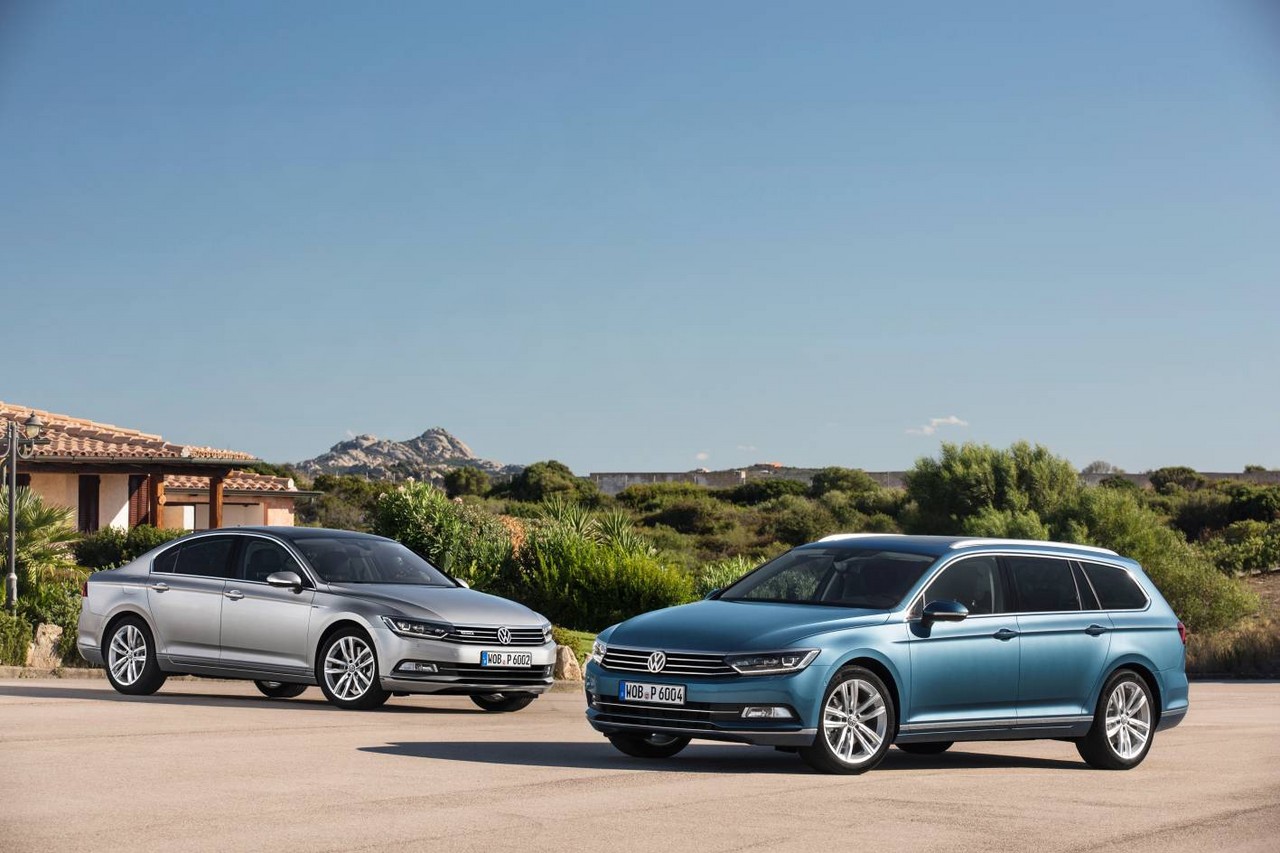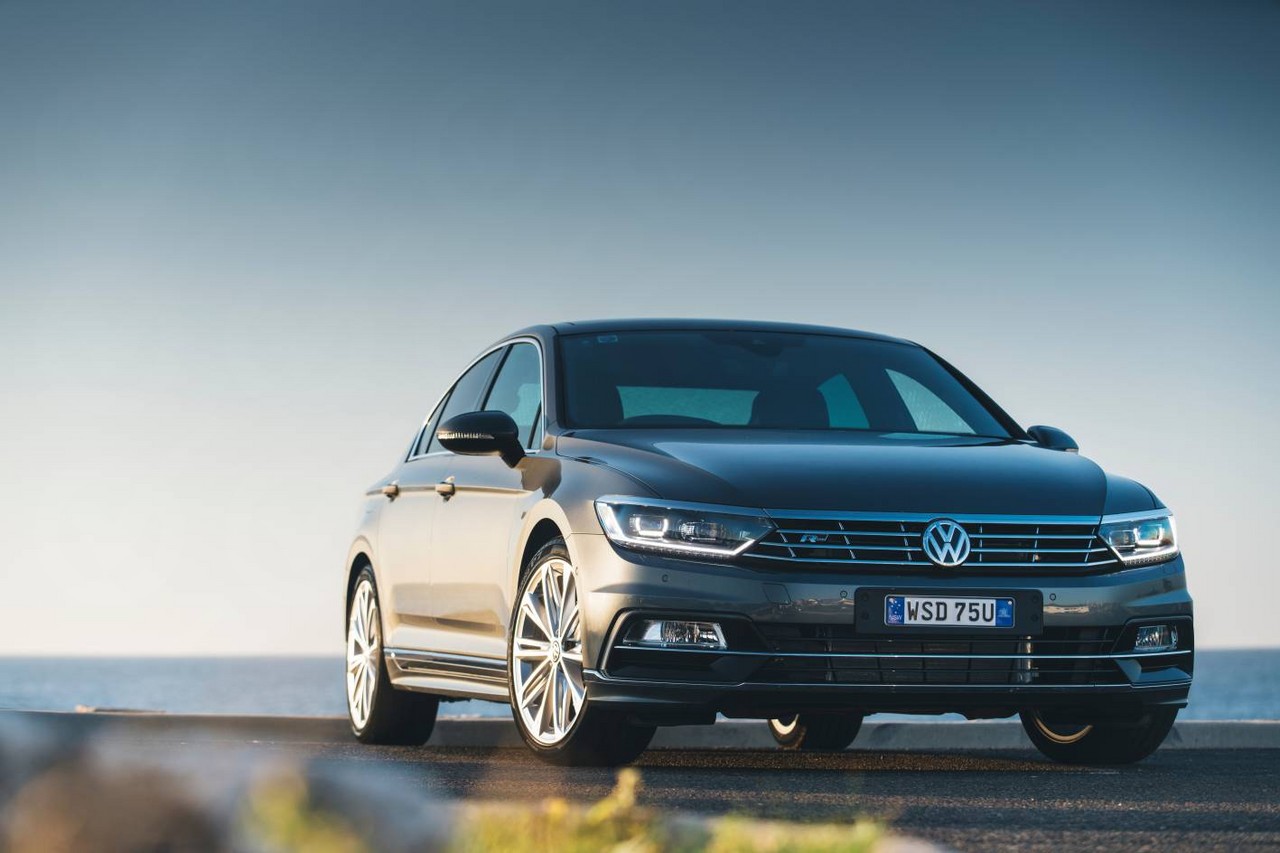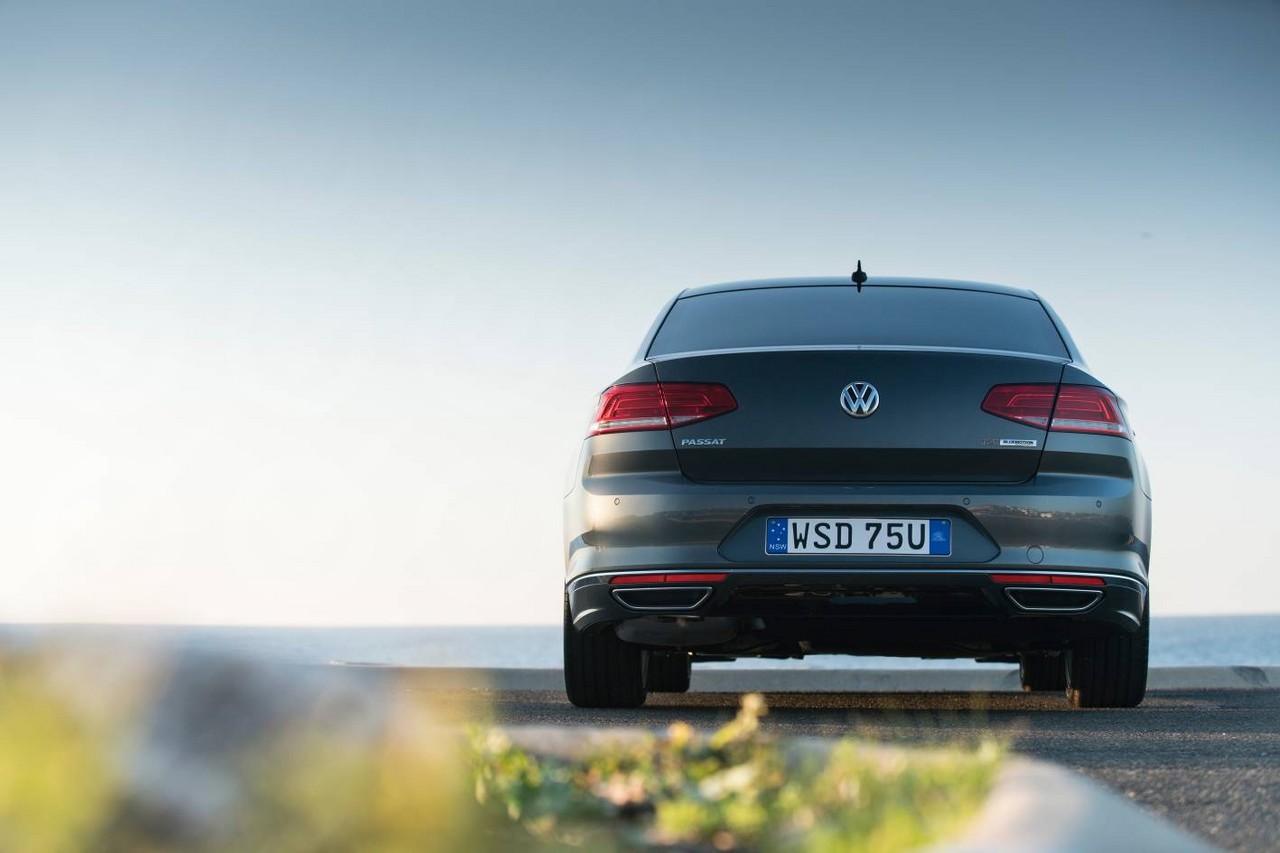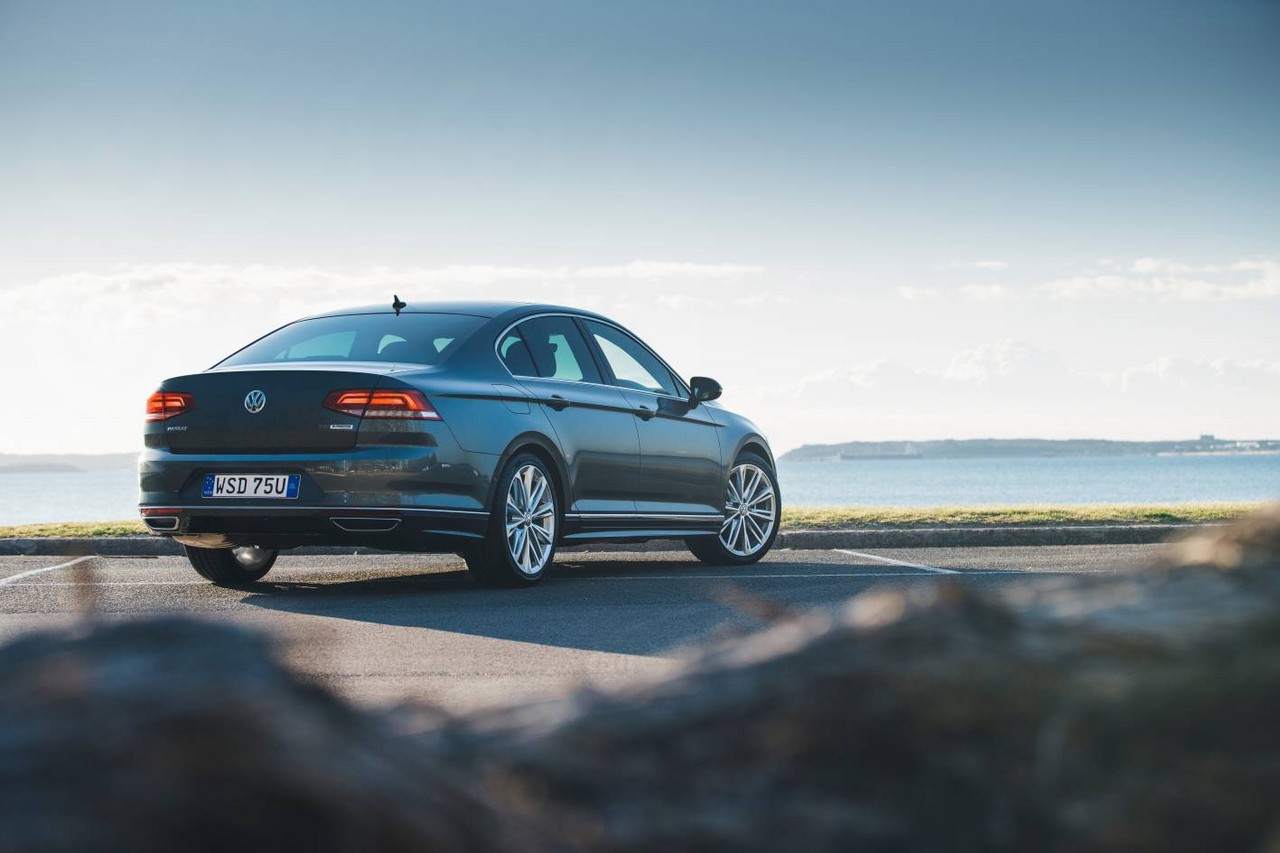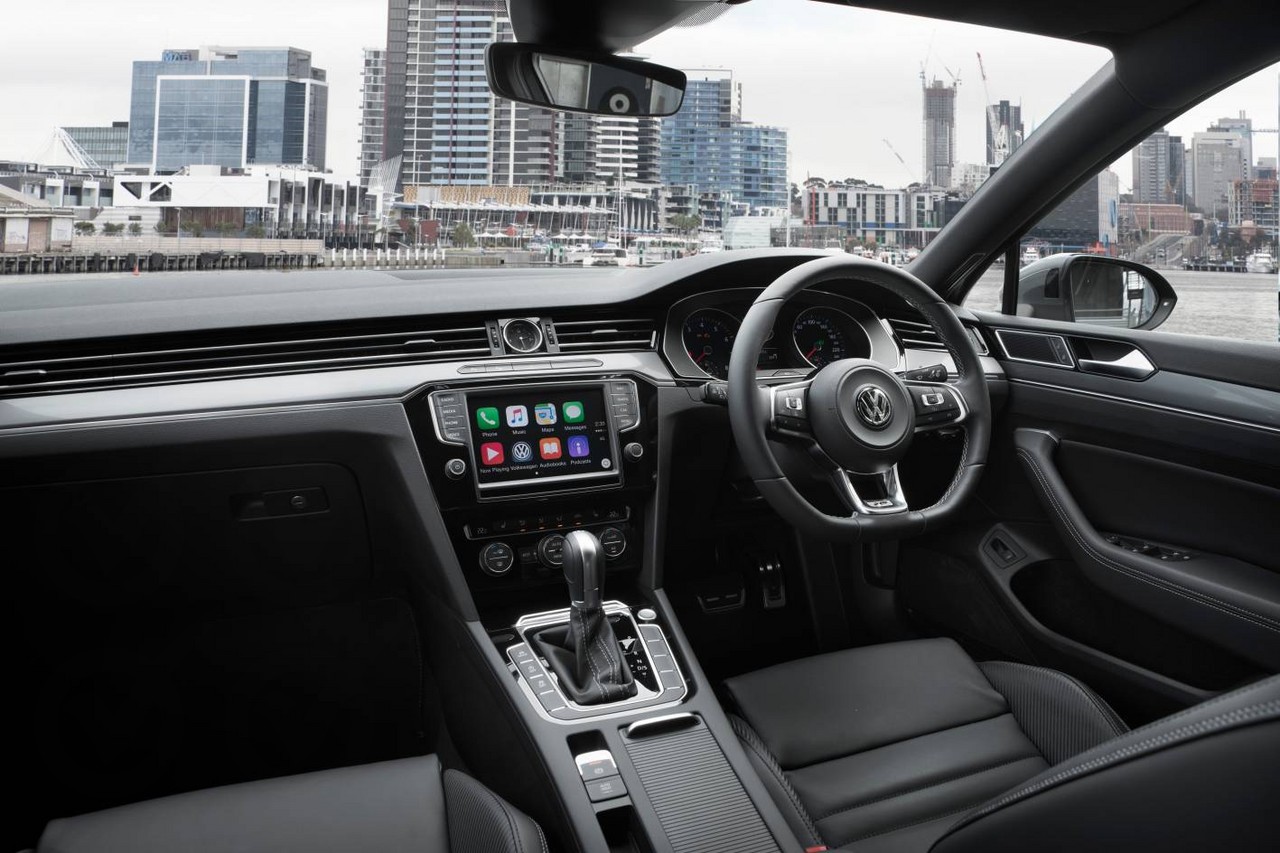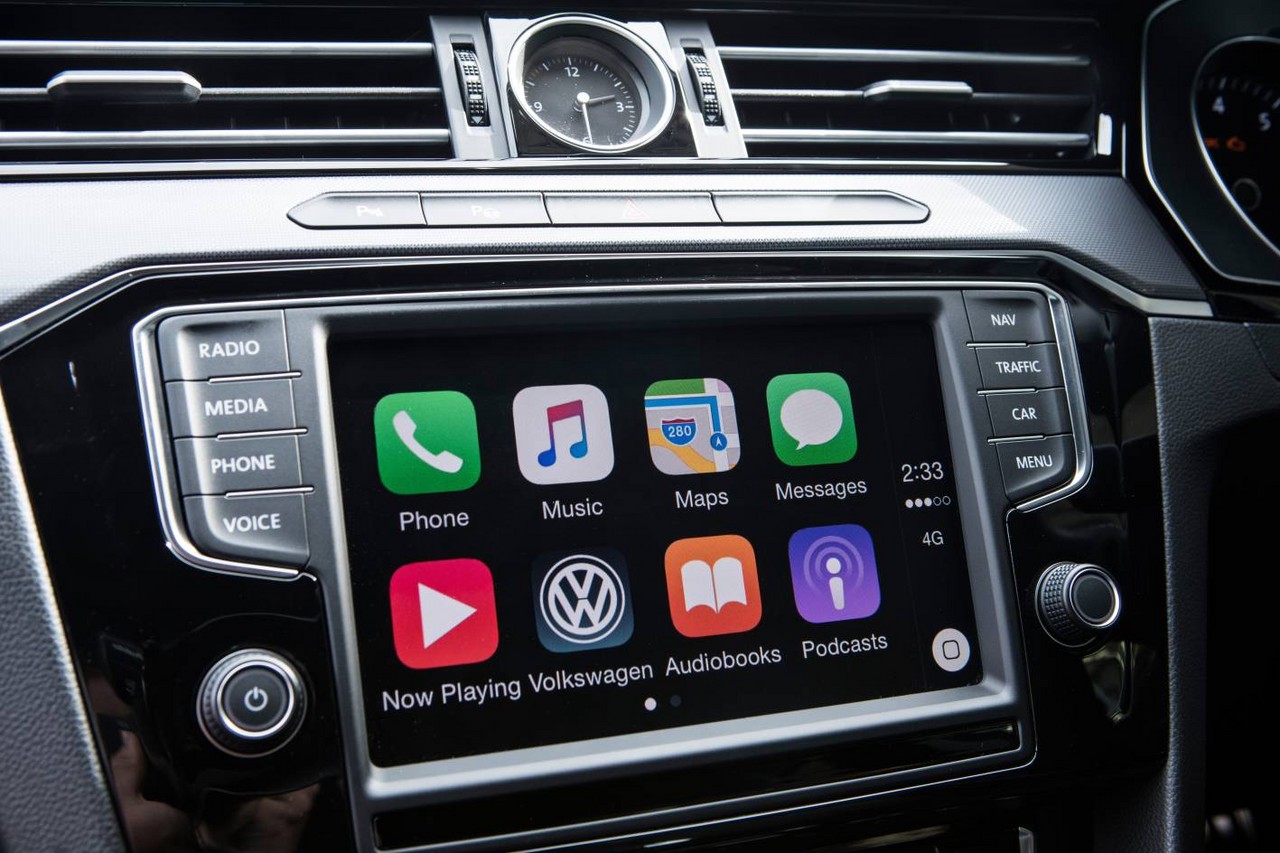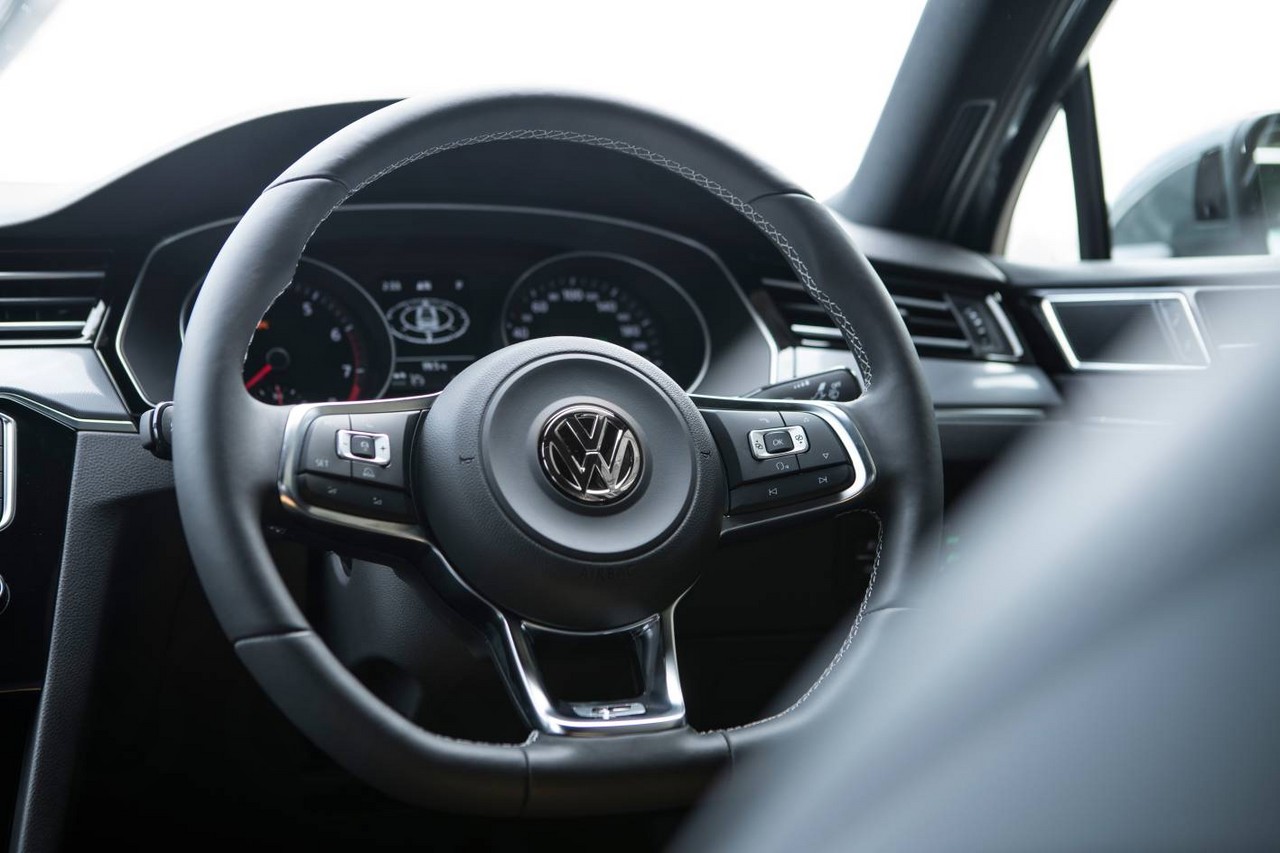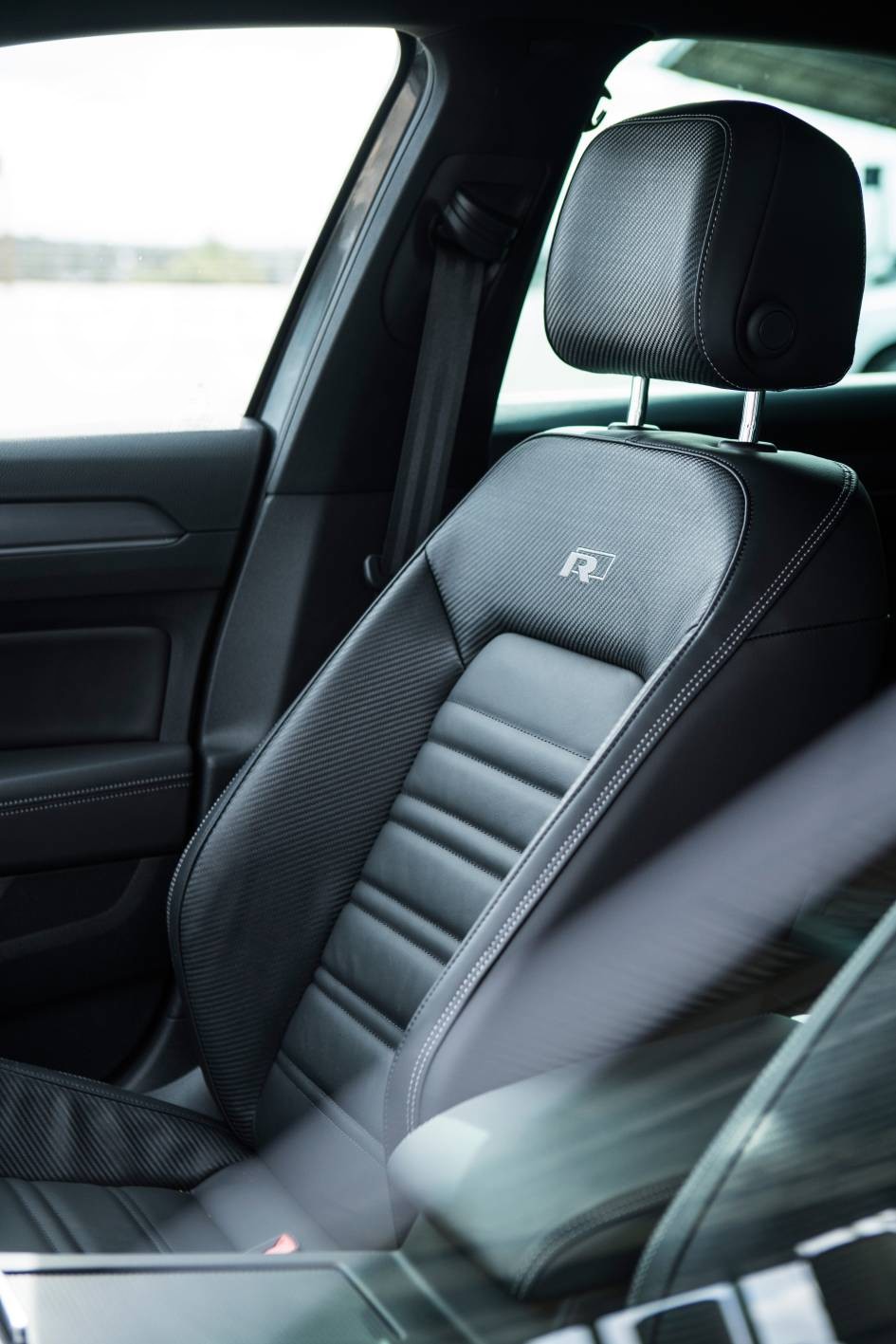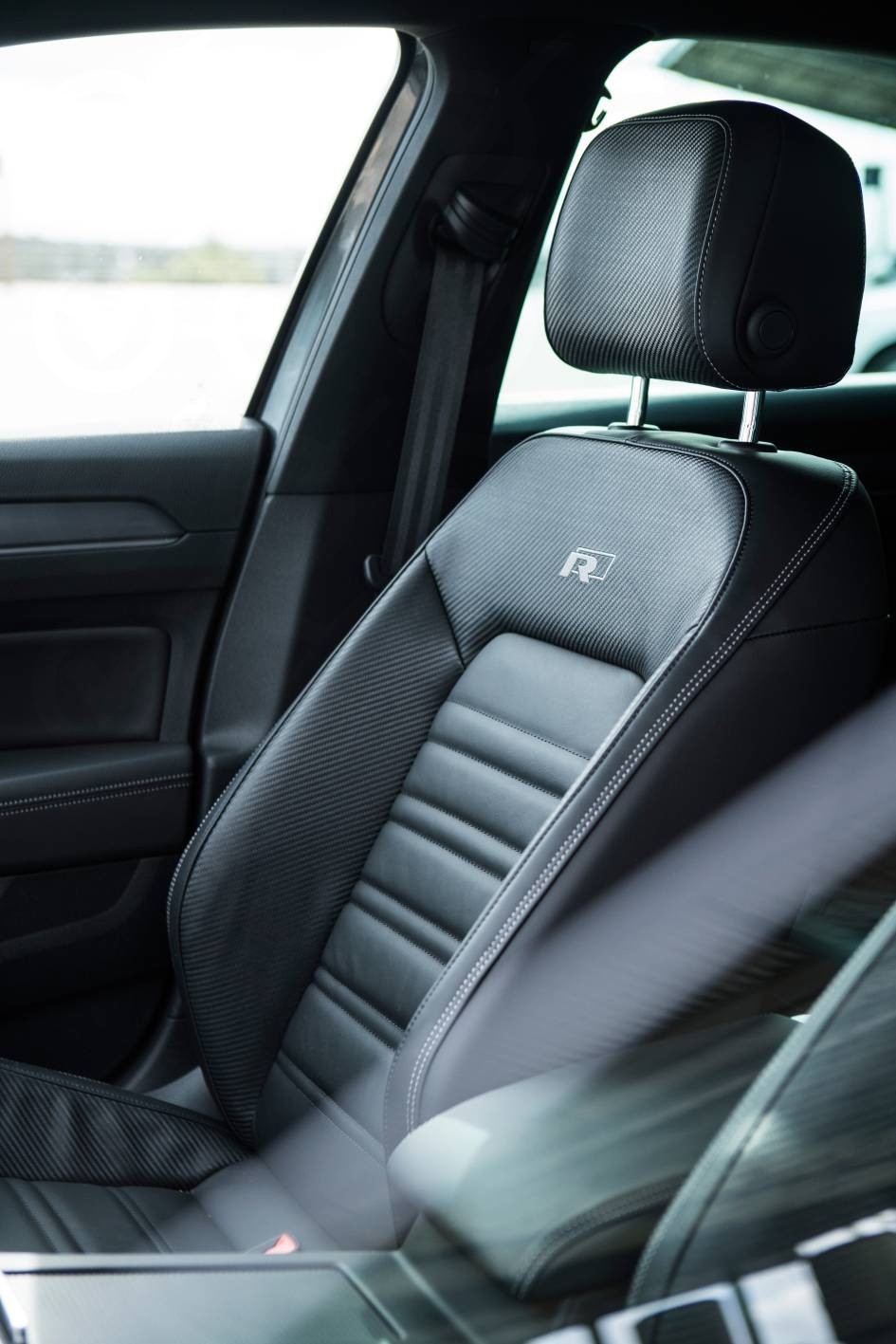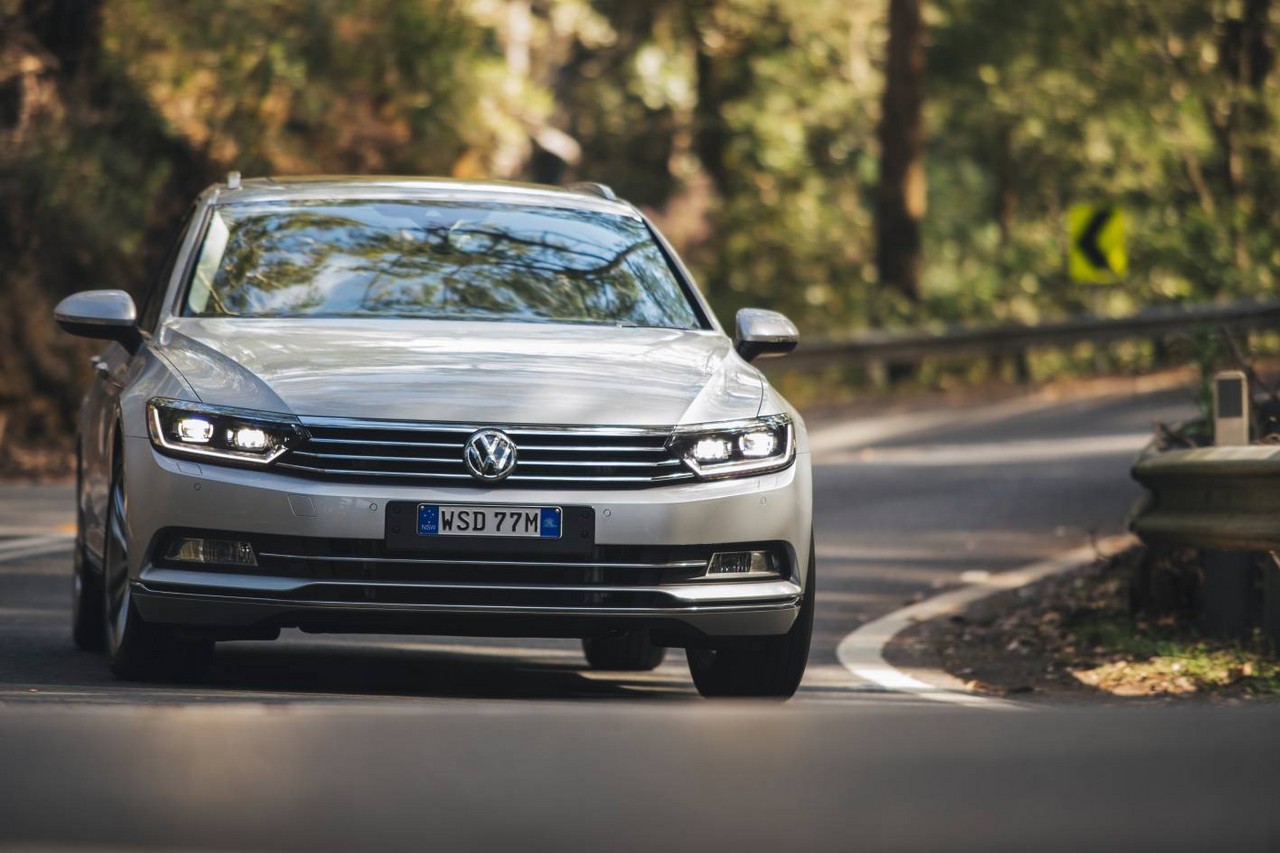
- Fuel-efficient and responsive engines
- Comfortable ride and competent dynamics
- Spacious interior and boot
- High standard of interior fit and finish
- Active safety technologies for Passat Comfortline and Highline
- Light steering lacks feedback
- Driving experience fails to engage the driver
- For R-Line package, sports suspension lacks compliance
- Elevated driving position
- Intrusive cabin noise
Volkswagen B8 Passat (2015-23)
Overview
Released in Australia in October 2015, the Volkswagen B8 Passat was available as a sedan or wagon. Manufactured in Germany, the front-wheel drive VW B8 Passat was available with 1.8-litre turbocharged petrol (‘132TSI’) or 2.0-litre turbo-diesel (‘140TDI’) engines.
In October 2016, the B8 Passat range was expanded with the introduction of the 206TSI R-Line which was powered by Volkswagen’s 2.0-litre turbocharged CJXA petrol engine.
| Body | Variant | Engine | Trans. | Peak power | Peak torque |
|---|---|---|---|---|---|
| Sedan, wagon |
132TSI, 132TSI Comfortline |
1.8-litre CJSA turbo petrol I4 | 7sp DCT | 132 kW at 5100-6200 rpm | 250 Nm at 1250-5000 rpm |
| 140TDI Highline | 2.0-litre DFCA turbo-diesel I4 | 6sp DCT | 140 kW at 3500-4000 rpm | 400 Nm at 1750-3000 rpm | |
| 206TSI R-Line | 2.0-litre CJXA turbo petrol I4 | 6sp DCT | 206 kW at 5600-6500 rpm | 350 Nm at 1700-6500 rpm |
Haldex V all-wheel drive system (‘4MOTION’)
As standard, the B8 Passat 206TSI R-Line was equipped with a Haldex V all-wheel drive system (Volkswagen’s ‘4MOTION’). The Haldex V system consisted an electronically controlled and hydraulically actuated multi-plate clutch coupling that was located in front of the rear axle differential (at the end of the prop shaft). Under low loads or when coasting, the rear axle was decoupled to reduce fuel consumption. If, however, there was a loss of front wheel traction or such a loss was anticipated by on-board sensors, then an electro-hydraulic oil pump would apply pressure to the clutch plates to transfer up to 50 per cent of the engine’s torque to the rear wheels (for a 50:50 front:rear torque split).
Body and dimensions
Underpinned by Volkswagen’s Modular Transverse Matrix (MQB), the Volkswagen B8 Passat was up to 85 kg lighter than the B7 Passat , in part due to lighter engines and the use of high-strength, hot-formed steel and aluminium. Despite mass reductions, body rigidity for the Passat wagon increased to 25,000 Nm/degree (from 23,000 Nm/degree) and to 30,000 Nm/degree for the Passat sedan.
Compared to the Volkswagen Mk.6 Passat , the B8 Passat was 2 mm shorter (at 4767 mm), 12 mm wider (1832 mm), 14 mm lower (1456 mm) and have a 79 mm longer wheelbase (2791 mm).
Suspension and steering
The Volkswagen B8 Passat had MacPherson strut front suspension and independent, four-link rear suspension. The Passat R-Line, however, was equipped with Volkswagen’s ‘Adaptive Chassis Control’ which consisted of electronically controlled dampers that continually adjusted to driving conditions.
The Volkswagen B8 Passat had rack-and-pinion steering with electric power assistance that varied according to vehicle speed. For the Passat R-Line, the steering had progressive ratios that varied with speed; as such, a higher ratio would mean that fewer turns were required for low-speed manoeuvres, while a lower ratio would provide greater control at higher speeds.
Safety equipment
Standard safety equipment for the Volkswagen Passat included dual front airbags, a driver’s knee airbag, front and rear side airbags, full-length curtain airbags, ABS, electronic brake force distribution, brake assist, electronic stability control, traction control, driver fatigue monitoring, post-collision braking, front seatbelts with pretensioners and load limiters, and outer rear seatbelt pre-tensioners.
As standard, the Passat Comfortline and Highline were further equipped with:
- Front Assist: used a radar sensor to detect if the vehicle was closing too fast on the vehicle ahead. If this occurred, Front Assist 1) provided audible and visual warnings to the driver, 2) brought the brake pads into contact with the brake discs for an emergency stop; and, 3) provided a jolting brake application to alert the driver. If the driver failed to respond, Front Assist would apply the brakes automatically to avoid or reduce the severity a collision;
- City Emergency Brake: an extension of Front Assist, City Emergency Braking operated at speeds up to 65 km/h and used a radar sensor and front camera to monitor the area ahead for vehicles and pedestrians. If a collision was anticipated, the driver was alerted via visual and audible warnings, followed by jolting brake application. If the driver failed to respond, the system would initiate emergency braking;
- Adaptive Cruise Control (ACC): using a radar sensor, ACC could maintain a pre-set distance to the vehicle ahead (including autonomous braking) and cause the vehicle to accelerate to its pre-set speed after braking;
- Rear Traffic Alert: when the driver was attempting to reverse out of a parking space, the Rear Traffic Alert system used radar sensors in the rear bumper to detect traffic up to 50 metres away that may cross the vehicle’s intended path. If a collision was considered imminent, Rear Traffic Alert would provide a visual warning, followed by an audible warning. If the driver did not respond to the warnings and there was an immediate collision risk, Rear Traffic Alert would automatically apply the brakes;
- Lane Assist (lane departure warning): using a camera to recognise lane markings, Lane Assist could detect unintentional lane drifting or changing and provide corrective steering actions for up to eight seconds. If the corrective steering actions were insufficient, the driver would be warned via steering wheel vibrations;
- Side Assist (lane change assistant): operated at speeds above 60 km/h and used two radar sensors in the rear bumper to monitor the area up to 70 metres behind the vehicle. If a vehicle was detected approaching from the rear or alongside the Passat, the driver was warned by illumination of an LED in the door mirror housing. If the driver then activated the turn indicator in the direction of the detected vehicle, the Side Assist indicator flashed to draw the driver’s attention to the mirror. If the driver attempted to steer into that area, the Lane Assist system would provide a counter-steering action to prevent the lane change.
For the standard Volkswagen Passat 132TSI, these technologies were initially available in the optional, extra-cost ‘Driver Assistance’ package. From August 2016, however, the Passat 132TSI was equipped with Front Assist and City Emergency Brake as standard.
Euro NCAP testing
In Euro NCAP testing , the 2014 Volkswagen Mk.7 Passat 2.0 TDI Comfortline received a five star safety rating which included an 85 per cent adult occupant protection rating and an 87 per cent child occupant protection rating. In the offset crash test, protection of the driver’s head, thighs and feet were rated as good, though chest and lower leg protection were rated as adequate (i.e. a slight risk of serious injury); protection of the front passenger was rated as good in all areas. In the side impact test, protection of all areas was rated as good. In the more severe pole test, however, protection of the driver’s chest and abdomen were rated as adequate.
Under ANCAP’s methodology , this testing resulted in a five star adult occupant protection rating with a score of 35.89 out of 37.
Features: Volkswagen Passat 132TSI
Standard features for the Volkswagen Passat 132TSI included 17-inch ‘Istanbul’ alloy wheels with 215/55 R17 tyres, Volkswagen’s ‘Discover Media’ audio and satellite navigation system with a 6.5-inch colour touch screen and two SD card slots, an eight speaker sound system, CD player, MP3/WMA/AAC compatibility and 3.5 mm auxiliary input, Bluetooth mobile phone connectivity and audio streaming, ‘Comfort’ front seats with cloth upholstery, a power adjustable driver’s seat, three-zone climate control air conditioning, a chillable and lockable glovebox, cruise control, daytime driving lights, a rear fog lamp, automatic headlights, rain-sensing wipers, front and rear parking sensors, rear view camera with static guidelines and distance to obstacles (Volkswagen’s ‘Optical Parking System’ or OPS), a leather-wrapped steering wheel and gearshift knob, 60/40 split and folding rear seats, remote central locking, power adjustable and heated door mirrors, power windows, tilt and telescopic steering wheel adjustment, height adjustable front seats, an auto-dimming rear view mirror, push-button start, illuminated vanity mirrors, tinted glass, three 12 volt power sockets (centre console, rear seat area and luggage compartment), tyre pressure monitoring, a trip computer and an immobiliser.
In the centre console, the ‘App-Connect’ USB interface supported Apple CarPlay, Android Auto and MirrorLink. As standard, Passat wagon models were fitted with an extendable net partition, an extendable luggage cover with automatic opening and chrome roof rails.
From August 2016, the B8 Passat was fitted with Volkswagen’s ‘Air Care’ three-zone climate control air conditioning system which included an air cleaning function and allergen filter. Furthermore, 17-inch ‘Soho’ alloy wheels were fitted as standard.
Features: Passat 132TSI Comfortline
Relative to the 132TSI, the Passat 132TSI Comfortline was further equipped with 17-inch ‘London’ alloy wheels, Volkswagen’s ‘Discover Pro’ audio and satellite navigation system with an eight-inch colour touch screen, 10GB hard drive and voice recognition, ‘Comfort sport’ front seats, ‘Vienna’ leather seat upholstery, individually heated front seats, directional front fog lights and a proximity key (i.e. keyless entry).
The Passat Comfortline wagon was also equipped with an ‘Easy Open’ function for rear tailgate which enabled it to open in response to motions below the bumper when the proximity key was in range. The ‘Easy Open’ function, however, was not fitted in combination with the optional R-Line package (described below) or for the Passat R-Line wagon.
In August 2016, standard features for the Passat Comfortline and Highline (see below) were extended to include fourteen-way power adjustable front seats, a massage function for the driver’s seat, memory function for the driver’s seat and door mirrors, power folding door mirrors, an auto-dimming driver’s side door mirror and kerb view function for the passenger side door mirror. Furthermore, the Passat 132TSI Comfortline gained Volkswagen’s ‘Driving Profile Selection’ – previously limited to the Passat Highline – which enabled the driver to select from Normal, Sport, Eco and Individual drive modes which adjusted accelerator pedal response, engine mapping, power steering assistance, transmission behaviour (DSG only) and air conditioning output.
Features: Passat 140TDI Highline
The Volkswagen Passat 140TDI Highline was distinguished by its 18-inch ‘Dartford’ alloy wheels with 235/45 R18 tyres, Nappa leather seat upholstery, colour trip computer display, deadlock mechanism, motion-sensing alarm and Volkswagen’s ‘Driving Profile Selection’ which enabled the driver to select from Normal, Sport, Eco and Individual drive modes.
Inside, the Passat 140TDI Highline had ‘piano black’ trim on the instrument cluster and gearshift lever surround, brushed aluminium inserts for the dashboard, centre console and doors, and chrome highlights for mirror and window switches. Externally, the Passat Highline could be identified by its chrome highlights for the front bumper outer air intakes and chrome mouldings for the bumper and side sills.
Features: Passat 206TSI R-Line
Compared to the Passat Highline, the Passat 206TSI R-Line was equipped with 19 x 8.0J ‘Verona’ alloy wheels with 235/40 R19 tyres, front sports seats in ‘Carbon Nappa’ leather upholstery, LED headlights (high and low beam) with dynamic cornering lights and washers, a flat-bottomed sports steering wheel with gearshift paddles, Volkswagen’s ‘Active Info Display’ (a 12.3 inch high-resolution display in place of the standard instrument cluster), ‘Silver Rise’ aluminium decorative inserts, black headlining and pillar trim, aluminium finish scuff plates, aluminium finish pedals, LED ambient lighting, rear privacy glass and a luggage net.
Visual cues for the Passat R-Line included its R-Line front bumper with spoiler and larger lower air intake, R-Line badge for the radiator grille, R-Line side sill extensions, R-Line rear bumper with trapezoidal exhaust trims and, for wagon models, a rear roof spoiler with black extensions.
Passat R-Line package
Available as an extra-cost option, the Passat’s R-Line package included 19-inch ‘Verona’ alloy wheels with 235/40 R19 tyres, 15 mm lower sports suspension, R-Line radiator grille badge, unique R-Line bumpers and side sills and rear privacy glass; for the Passat wagon, the R-Line package also included a rear roof spoiler with aerodynamic extensions. The R-Line package also included progressive ratio steering.
Inside, the R-Line package featured sports front seats in ‘Carbon Nappa’ seat upholstery, three-spoke flat-bottom sports steering wheel with gearshift paddles, ‘piano black’ inlays for the instrument surround and centre console, ‘black lead grey’ inserts for the dashboard and door trim, aluminium finishes for the door scuff plates and pedals, and black headlining and pillar trim.
From August 2016, the R-Line package included 18-inch ‘Monterey’ grey metallic alloy wheels and Volkswagen’s ‘Active Info Display’ (i.e. digital instrument cluster) was added.
Specifications
- Specifications: Volkswagen B8 Passat (October 2015)
- Specifications: Volkswagen B8 Passat (September 2016)
Related links
